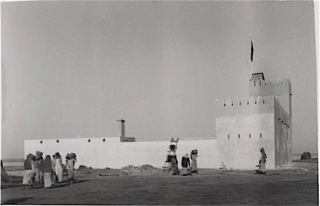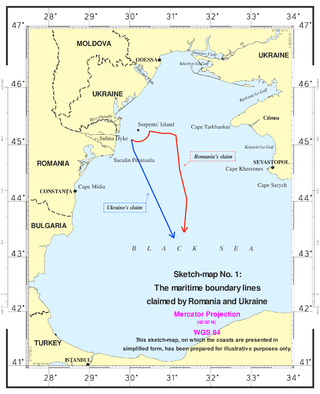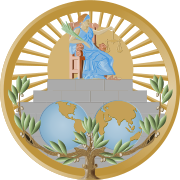
The Hawar Islands are an archipelago of desert islands; all but one are owned by Bahrain, while the southern, small, and uninhabited Jinan Island is administered by Qatar as part of its Al-Shahaniya municipality. The archipelago is situated off the west coast of Qatar in the Gulf of Bahrain of the Persian Gulf.

The International Court of Justice, also called the World Court, is the only international court that adjudicates general disputes between nations, and gives advisory opinions on international legal issues. It is one of the six organs of the United Nations (UN), and is located in The Hague, Netherlands.
The Cod Wars were a series of 20th-century confrontations between the United Kingdom and Iceland about fishing rights in the North Atlantic. Each of the disputes ended with an Icelandic victory.

Machias Seal Island is an island in disputed water between the Gulf of Maine and the Bay of Fundy, about 16 km (10 mi) southeast from Cutler, Maine, and 19 km (12 mi) southwest of Grand Manan Island, New Brunswick. Sovereignty of the island is disputed by the United States and Canada. The Canadian Coast Guard continues to staff a lighthouse on the island; the first lighthouse was constructed there in 1832.

Serranilla Bank is a partially submerged reef, with small uninhabited islets, in the western Caribbean Sea. It is situated about 350 kilometres (220 mi) northeast of Punta Gorda, Nicaragua, and roughly 280 kilometres (170 mi) southwest of Jamaica. The closest neighbouring land feature is Bajo Nuevo Bank, located 110 kilometres (68 mi) to the east.

Bajo Nuevo Bank, also known as the Petrel Islands, is a small, uninhabited reef with some small grass-covered islets, located in the western Caribbean Sea at 15°53′N78°38′W, with a lighthouse on Low Cay at 15°51′N78°38′W. The closest neighbouring land feature is Serranilla Bank, located 110 kilometres to the west.

An exclusive economic zone (EEZ), as prescribed by the 1982 United Nations Convention on the Law of the Sea, is an area of the sea in which a sovereign state has exclusive rights regarding the exploration and use of marine resources, including energy production from water and wind. EEZ does not define the ownership of any maritime features within the EEZ.

Pedra Branca is an outlying island and the easternmost point of Singapore. The name of the island refers to whitish guano deposited on the rock. The island consists of a small outcrop of granite rocks with an area of about 8,560 square metres (92,100 sq ft) at low tide. During the low water spring tide it measures, at its longest, 137 metres (449 ft) and has an average width of 60 metres (200 ft). Pedra Branca is situated at 1°19′48″N104°24′27″E, where the Singapore Strait meets the South China Sea.

The Turbot War was an international fishing dispute and bloodless conflict between Canada and Spain and their respective supporters.
The International Court of Justice has jurisdiction in two types of cases: contentious cases between states in which the court produces binding rulings between states that agree, or have previously agreed, to submit to the ruling of the court; and advisory opinions, which provide reasoned, but non-binding, rulings on properly submitted questions of international law, usually at the request of the United Nations General Assembly. Advisory opinions do not have to concern particular controversies between states, though they often do.
Territorial disputes of Nicaragua include the territorial dispute with Colombia over the Archipelago of San Andrés, Providencia and Santa Catalina and Quita Sueño Bank. Nicaragua also has a maritime boundary dispute with Honduras in the Caribbean Sea and a boundary dispute over the Rio San Juan with Costa Rica.

The Corfu Channel case was the first public international law case heard before the International Court of Justice (ICJ) between 1947 and 1949, concerning state responsibility for damages at sea, as well as the doctrine of innocent passage. A contentious case, it was the first of any type heard by the ICJ after its establishment in 1945.

France v United Kingdom [1953] ICJ 3 was an International Court of Justice case concerning sovereignty over seas.

The Oil Platforms case is a public international law case decided by the International Court of Justice in 2003 in which Iran challenged the U.S. Navy's destruction of three oil platforms in the Persian Gulf in 1987-1988. The Court affirmed that it could exercise jurisdiction over the case based on the 1955 Treaty of Amity, Economic Relations and Consular Rights between the United States and Iran but decided with strong majorities against both Iran's claim and the United States' counterclaim.

Romania–Ukraine relations are foreign relations between Romania and Ukraine. Diplomatic relations between both countries were established on February 9, 1918, and re-established in 1992. In 2020, it was announced that Romania would open a consulate for Ukraine in Sighetu Marmației.

The Pedra Branca dispute was a territorial dispute between Singapore and Malaysia over several islets at the eastern entrance to the Singapore Strait, namely Pedra Branca, Middle Rocks and South Ledge. The dispute began in 1979 and was largely resolved by the International Court of Justice (ICJ) in 2008, which opined that Pedra Branca belonged to Singapore and Middle Rocks belonged to Malaysia. Sovereignty over South Ledge belongs to the state in the territorial waters of which it is located.

The Case concerning maritime delimitation in the Black Sea (Romania v Ukraine) [2009] ICJ 3 was a decision of the International Court of Justice (ICJ). On September 16, 2004, Romania brought its case to the court after unsuccessful bilateral negotiations. On February 3, 2009, the court handed down its verdict, establishing a maritime boundary including the continental shelf and exclusive economic zones for Romania and Ukraine.

The Overseas Patrol Squadron is a front-line squadron of the Royal Navy with responsibility for patrolling the UK's Extended Fisheries Zone, both at home and around British Overseas Territories. The squadron, with headquarters at HMNB Portsmouth, is equipped with eight of the River-class patrol vessels.
Spain's exclusive economic zone (EEZ) is the 30th largest in the world with 1,039,233 km2 (401,250 sq mi). It is mostly in the Atlantic Ocean and the Mediterranean Sea. This is approximately double the entire Spanish land area. Together the land and sea surface would account for approximately 0.3% of the world's land surface.











